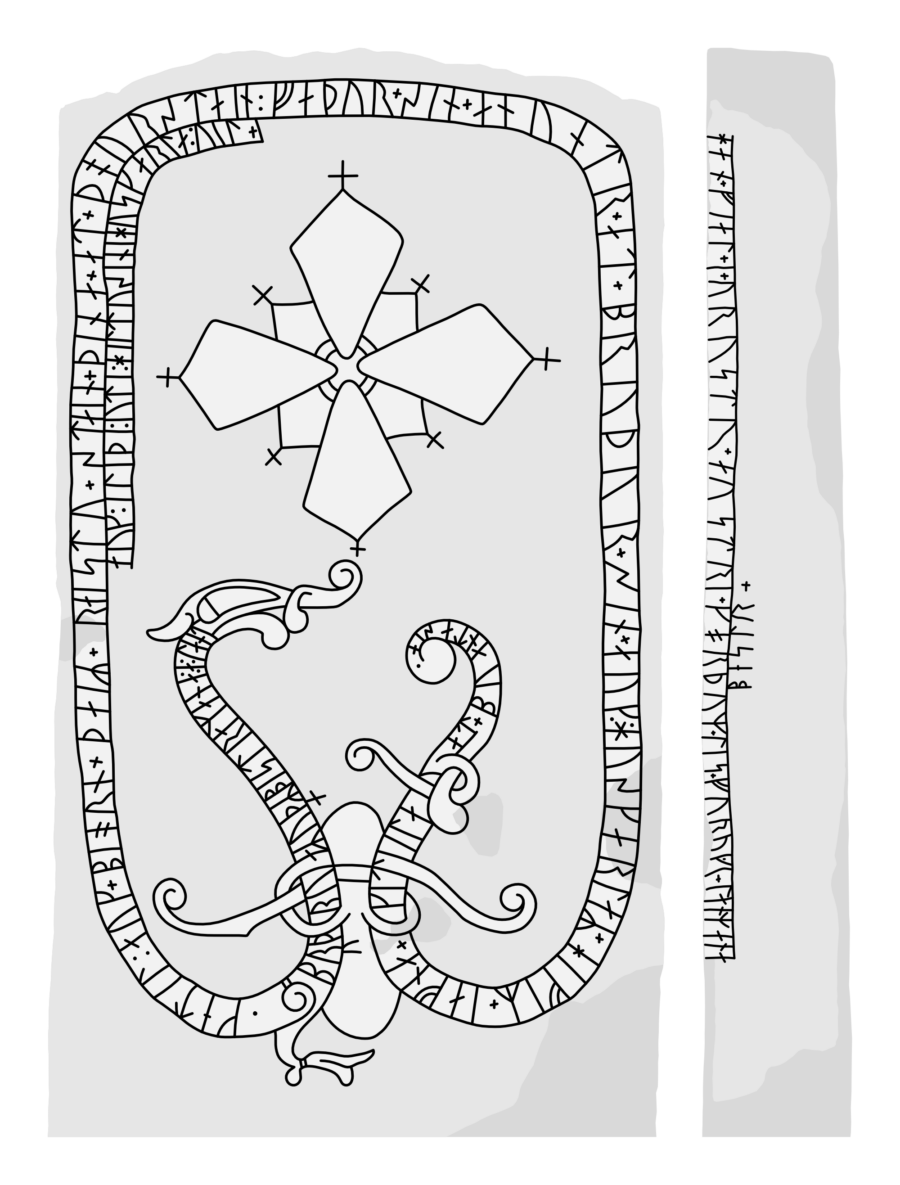
Runestone Sö 338
January 6, 2022
The carvings of the stone are in the runestone style Pr 4 (c. 1070-1100) pertaining to the Urnes style.
The inscription is not signed.
The red sandstone slab is c. 2,09 m tall and 1,19 m wide.
Runic inscription
The first part of the rune text begins just behind the animal’s front leg. The second part begins just in front of the leg running in the opposite direction. The third part runs in a separate ribbon in the top left corner, parallel to the animal ribbon. The fourth part runs along the edge on the left side of the stone.
Runes
[1] ᛫ ᚴᛂᛏᛁᛚ ᛬ ᛅᚢᚴ + ᛒᛁᚬᚱᚾ + ᚦᛅᛁᛦ + ᚱᛅᛁᛋᛏᚢ + ᛋᛏᛅᛁᚾ + ᚦᛁᚾᛅ + ᛅᛏ + ᚦᚬᚢᚱᛋᛅᛁᚾ ᛬ ᚠᛅᚦᚢᚱ + ᛋᛁᚾ + ᛅᚾᚢᚾᛏᚱ + ᛅᛏ + ᛒᚱᚢᚦᚢᚱ + ᛋᛁᚾ + ᛅᚢᚴ ᛬ ᚼᚢ[ᛋᚴᛅᚱ]ᛚᛅᛦ + ᚼᛁᚠᛁᛦ + ᛁᛅᚠᚾᛅ + ᚴᛁᛏᛁᛚᛅᚢ ᛅᛏ + ᛒᚢᛅᚾᛏᛅ ᛋᛁᚾ ᛫ [2] ᛒᚱᚢᚦᚱ ᚢᛅᛦᚢ ᚦᛅᛦ ᛒᛁᛋᛏᚱᛅ ᛘᛅᚾᛅ ᛬ ᛅ ᛬ ᛚᛅᚾᛏᛁ [3] ᛅᚢᚴ ᛬ ᛁ ᛚᛁᚦᛁ ᛬ ᚢᛏᛁ ᛬ ᚼ(ᛁ)(ᛚ)(ᛏ)ᚢ ᛋᛁᚾᛁ ᚼᚢᛋᚴᛅᚱᛚᛅ ᛬ ᚢᛁᛚ + [4] ᚼᛅᚾ + ᚠᛁᛅᛚ + ᛁ + ᚢᚱᚢᛋᛏᚢ + ᛅᚢᛋᛏᚱᛁ + ᚴᚯᚱᚦᚢᛘ + ᛚᛁᛋ + ᚠᚢᚱᚢᚵᛁ + ᛚᛅᚾᛘᛅᚾᛅ ¶ ᛒᛂᛋᛏᚱ +
Transliteration
* ketil : auk + biorn + þaiʀ + raistu + stain + þin[a] + at + þourstain : faþur + sin + anuntr + at + bruþur + sin + auk : hu[skar]laʀ + hifiʀ + iafna + ketilau at + buanta sin * ¶ bruþr uaʀu þaʀ bistra mana : a : lanti auk : i liþi : uti : h(i)(l)(t)u sini huska(r)la : ui- + han + fial + i + urustu + austr i + garþum + lis + furugi + lanmana + bestr
Old Norse
Kætill ok Biorn þæiR ræistu stæin þenna at Þorstæin, faður sinn, Anundr at broður sinn ok huskarlaR æftiR(?) iafna, Kætiløy at boanda sinn.
Brøðr vaRu þæiR
bæztra manna,
a landi
ok i liði uti,
heldu sina
huskarla ve[l].
Hann fioll i orrustu
austr i Garðum,
liðs forungi,
landmanna bæztr.
English
Ketill and Bjǫrn, they raised this stone in memory of Thorsteinn, their father; Ônundr in memory of his brother and the housecarls in memory of the just(?) (and) Ketiley in memory of her husbandman.
These brothers
were the best of men
in the land
and abroad in the retinue,
held their
housecarls well.
He fell in battle in the east
in Garðar (Russia),
commander of the retinue,
the best of lanðolders.
Notes
The last part of the text is in poetic form, comprising five alliterative pairs.
———
Turinge, Södermanland, Sweden
Sö 338